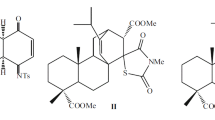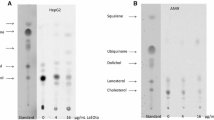Abstract
Background
2,4,5-Trimethoxycinnamic acid (2,4,5-TMC) is the major and non-toxic metabolite of α-asarone, which retains hypocholesterolemic and choleretic activities. We compared the activities of 2,4,5-TMC with those of 2,4-dimethoxycinnamic acid (2,4-DMC), 3,4-DMC and 3,5-DMC, to understand the role of the methoxyls on carbons 2, 4 and 5 on the pharmacologic properties of these compounds.
Methods
The methoxycinnamic acids were administered to high-cholesterol/cholate-fed rats. We measured bile flow, and quantified bile acids, phospholipids and cholesterol in bile, and cholesterol and cholesterol-lipoproteins in serum. The inhibition of HMG-CoA reductase by the methoxycinnamic acids was evaluated in vitro.
Results
The four methoxycinnamic acids decreased serum cholesterol, without affecting the concentration of HDL-cholesterol. 2,4,5-TMC produced the highest decrease in LDL-cholesterol, 73.5%, which exceeds the range of statins (20–40%), and produced the highest inhibition of the activity of HMG-CoA reductase. 3,4-DMC produced the highest increase in bile flow, bile acids and phospholipids concentrations, and reduction in bile cholesterol, which led to a decrease in the biliary cholesterol saturation index.
Conclusions
2,4,5-TMC (which has three methoxyls) had the highest hypocholesterolemic activity, while 3,4-DMC, which lacks the methoxyl in carbon 2 but conserves the two other methoxyls in an adjacent position, had the highest choleretic activity and a probable cholelitholytic activity. In methoxycinnamic acids with two methoxyls in non-adjacent positions (2,4-DMC and 3,5-DMC), the hypocholesterolemic and choleretic activities were not as evident. 2,4,5-TMC and 3,4-DMC, which did not cause liver damage during the treatment period, should be further explored as a hypocholesterolemic and choleretic compounds in humans.
Similar content being viewed by others
References
Martínez M. The medicinal plants of Mexico. México: Ediciones Botas; 1992. p. 47–55.
Mandoki JJ, Krumm-Heller C, Vega-Noverola J, Wong-Ramírez C, Arriaga C, Roa R, et al. Isolation of α-asarone from the bark of Guatteria gaumeri (Elemuy) and the study of its hypocholesterolemic effect. In: IV National Congress of Pharmacology; 1980.
Rodriguez-Paez L, Juarez-Sanchez M, Antunez-Solis J, Baeza I, Wong C. Alphaasarone inhibits HMG-CoA reductase, lowers serum LDL-cholesterol levels and reduces biliary CSI in hypercholesterolemic rats. Phytomedicine 2003;10(5):397–404.
Marczewska J, Drozd E, Anuszewska E, Chilmonczyk Z, Lozowicka B. Assessment of the genotoxic activity of alpha-asarone and its derivatives in the comet assay. Acta Pol Pharm 2013;70(2):349–54.
Antunez-Solis J, Hernandez-Derramadero F, Aquino-Vega M, Ibarra-Ramirez S, Rodriguez-Paez L, Baeza I, et al. 2,4,5-Trimethoxycinnamic acid: the major metabolite of alpha-asarone, retains most of the pharmacological properties of alpha-asarone. J Enzyme Inhib Med Chem 2009;24(3):903–9.
Trapani L, Segatto M, Pallottini V. Regulation and deregulation of cholesterol homeostasis: the liver as a metabolic power station. World J Hepatol 2012;4(6):184–90.
Kumar N, Mudgal J, Parihar VK, Nayak PG, Kutty NG, Rao CM. Sesamol treatment reduces plasma cholesterol and triacylglycerol levels in mouse models of acute and chronic hyperlipidemia. Lipids 2013;48(6):633–8.
Durcekova T, Mocak J, Boronova K, Balla J. Effect of the statin therapy on biochemical laboratory tests – a chemometrics study. J Pharm Biomed Anal 2011;54(1):141–7.
Tomaszewski M, Stepien KM, Tomaszewska J, Czuczwar SJ. Statin-induced myopathies. Pharmacol Rep 2011;63(4):859–66.
National Research Council (U.S.). Committee for the Update of the Guide for the Care and Use of Laboratory Animals, Institute for Laboratory Animal Research (U.S.), National Academies Press (U.S.). Guide for the care and use of laboratory animals. Washington, DC: National Academies Press; 2011 , Available from: https://doi.org/www.ncbi.nlm.nih.gov/books/NBK54050 ebrary http://site.ebrary.com/id/10443276 National Academies Press, http://www.nap.edu/catalog.php?record_id=12910 National Academies Press, http://www.nap.edu/catalog.php?record_id=12910 – toc, http://www.ncbi.nlm.nih.gov/bookshelf/br.fcgi?book=nap12910, http://grants.nih.gov/grants/olaw/Guide-for-the-Care-and-use-of-laboratory-animals.pdfbooks/NBK54050 ebrary http://site.ebrary.com/id/10443276 National Academies Press, http://www.nap.edu/catalog.php?record_id=12910 National Academies Press, http://www.nap.edu/catalog.php?record_id=12910 – toc, http://www.ncbi.nlm.nih.gov/bookshelf/br.fcgi?book=nap12910, http://grants.nih.gov/grants/olaw/Guide-for-the-Care-and-use-of-laboratory-animals.pdf.
Turley SD, Dietschy JM. Re-evaluation of the 3 alpha-hydroxysteroid dehydrogenase assay for total bile acids in bile. J Lipid Res 1978;19(7):924–8.
Carey MC. Critical tables for calculating the cholesterol saturation of native bile. J Lipid Res 1978;19(8):945–55.
Aberare OL, Okuonghae P, Mukoro N, Dirisu JO, Osazuwa F, Odigie E, et al. Triglycerides, total cholesterol, high density lipoprotein cholesterol and low density lipoprotein cholesterol in rats exposed to premium motor spirit fumes. N Am J Med Sci 2011;3(6):277–80.
Ahmad S, Beg ZH. Elucidation of mechanisms of actions of thymoquinoneenriched methanolic and volatile oil extracts from Nigella sativa against cardiovascular risk parameters in experimental hyperlipidemia. Lipids Health Dis 2013;12:86.
Ghaffari T, Nouri M, Irannejad E, Rashidi MR. Effect of vitamin e and selenium supplement on paraoxonase-1 activity, oxidized low density lipoprotein and antioxidant defense in diabetic rats. Bioimpacts 2011;1(2):121–8.
Nounou HA, Deif MM, Shalaby MA. Effect of flaxseed supplementation and exercise training on lipid profile, oxidative stress and inflammation in rats with myocardial ischemia. Lipids Health Dis 2012;11:129.
Quesada H, del Bas JM, Pajuelo D, Diaz S, Fernandez-Larrea J, Pinent M, et al. Grape seed proanthocyanidins correct dyslipidemia associated with a high-fat diet in rats and repress genes controlling lipogenesis and VLDL assembling in liver. Int J Obes (Lond) 2009;33(9):1007–12.
Russell DW. The enzymes, regulation, and genetics of bile acid synthesis. Annu Rev Biochem 2003;72:137–74.
Gupta S, Pandak WM, Hylemon PB. LXR alpha is the dominant regulator of CYP7A1 transcription. Biochem Biophys Res Commun 2002;293(1):338–43.
Xu G, Pan LX, Li H, Shang Q, Honda A, Shefer S, et al. Dietary cholesterol stimulates CYP7A1 in rats because farnesoid X receptor is not activated. Am J Physiol Gastrointest Liver Physiol 2004;286(5):G730–5.
Roach PD, Balasubramaniam S, Hirata F, Abbey M, Szanto A, Simons LA, et al. The low-density lipoprotein receptor and cholesterol synthesis are affected differently by dietary cholesterol in the rat. Biochim Biophys Acta 1993;1170(2):165–72.
Spady DK, Cuthbert JA. Regulation of hepatic sterol metabolism in the ra. Parallel regulation of activity and mRNA for 7 alpha-hydroxylase but not 3-hydroxy-3-methylglutaryl-coenzyme A reductase or low density lipoprotein receptor. J Biol Chem 1992;267(8):5584–91.
Shibata S, Hayakawa K, Egashira Y, Sanada H. Roles of nuclear receptors in the up-regulation of hepatic cholesterol 7alpha-hydroxylase by cholestyramine in rats. Life Sci 2007;80(6):546–53.
Voet D, Voet JG, Pratt CW. Principles of biochemistry. 4th ed. John Wiley: Hoboken, NJ; 2013, xxxii, 1077, SP-21, G-23, I-44 p..
Davis BT, Wang XJ, Rohret JA, Struzynski JT, Merricks EP, Bellinger DA, et al. Targeted disruption of LDLR causes hypercholesterolemia and atherosclerosis in Yucatan miniature pigs. PLOS ONE 2014;9(4):e93457.
Luo QF, Sun L, Si JY, Chen DH. Hypocholesterolemic effect of stilbenes containing extract-fraction from Cajanus cajan L. on diet-induced hypercholesterolemia in mice. Phytomedicine 2008;15(11):932–9.
Ivaturi S, Wooten CJ, Nguyen MD, Ness GC, Lopez D. Distribution of the LDL receptor within clathrin-coated pits and caveolae in rat and human liver. Biochem Biophys Res Commun 2014;445(2):422–7.
Trapani L, Segatto M, Pallottini V. New compounds able to control hepatic cholesterol metabolism: is it possible to avoid statin treatment in aged people? World J Hepatol 2013;5(12):676–84.
Sirtori CR. The pharmacology of statins. Pharmacol Res 2014;88:3–11.
Lusis AJ. Atherosclerosis. Nature 2000;407(6801):233–41.
Wang Y, Karu K, Meljon A, Turton J, Yau JL, Seckl JR, et al. 24S,25-Epoxycholesterol in mouse and rat brain. Biochem Biophys Res Commun 2014;449(2):229–34.
Shibata S, Hayakawa K, Egashira Y, Sanada H. Hypocholesterolemic mechanism of Chlorella: Chlorella and its indigestible fraction enhance hepatic cholesterol catabolism through up-regulation of cholesterol 7alpha-hydroxylase in rats. Biosci Biotechnol Biochem 2007;71(4):916–25.
Cao Y, Bei W, Hu Y, Cao L, Huang L, Wang L, et al. Hypocholesterolemia of Rhizoma Coptidis alkaloids is related to the bile acid by up-regulated CYP7A1 in hyperlipidemic rats. Phytomedicine 2012;19(8–9):686–92.
Duane WC, Hunninghake DB, Freeman ML, Pooler PA, Schlasner LA, Gebhard RL. Simvastatin, a competitive inhibitor of HMG-CoA reductase, lowers cholesterol saturation index of gallbladder bile. Hepatology 1988;8(5):1147–50.
Mitchell JC, Logan GM, Stone BG, Duane WC. Effects of lovastatin on biliary lipid secretion and bile acid metabolism in humans. J Lipid Res 1991;32(1):71–8.
Smit JW, van Erpecum KJ, Stolk MF, Geerdink RA, Cluysenaer OJ, Erkelens DW, et al. Successful dissolution of cholesterol gallstone during treatment with pravastatin. Gastroenterology 1992;103(3):1068–70.
Author information
Authors and Affiliations
Corresponding author
Rights and permissions
About this article
Cite this article
Serna, M., Wong-Baeza, C., Santiago-Hernández, JC. et al. Hypocholesterolemic and choleretic effects of three dimethoxycinnamic acids in relation to 2,4,5-trimethoxycinnamic acid in rats fed with a high-cholesterol/cholate diet. Pharmacol. Rep 67, 553–559 (2015). https://doi.org/10.1016/j.pharep.2014.12.009
Received:
Revised:
Accepted:
Published:
Issue Date:
DOI: https://doi.org/10.1016/j.pharep.2014.12.009




